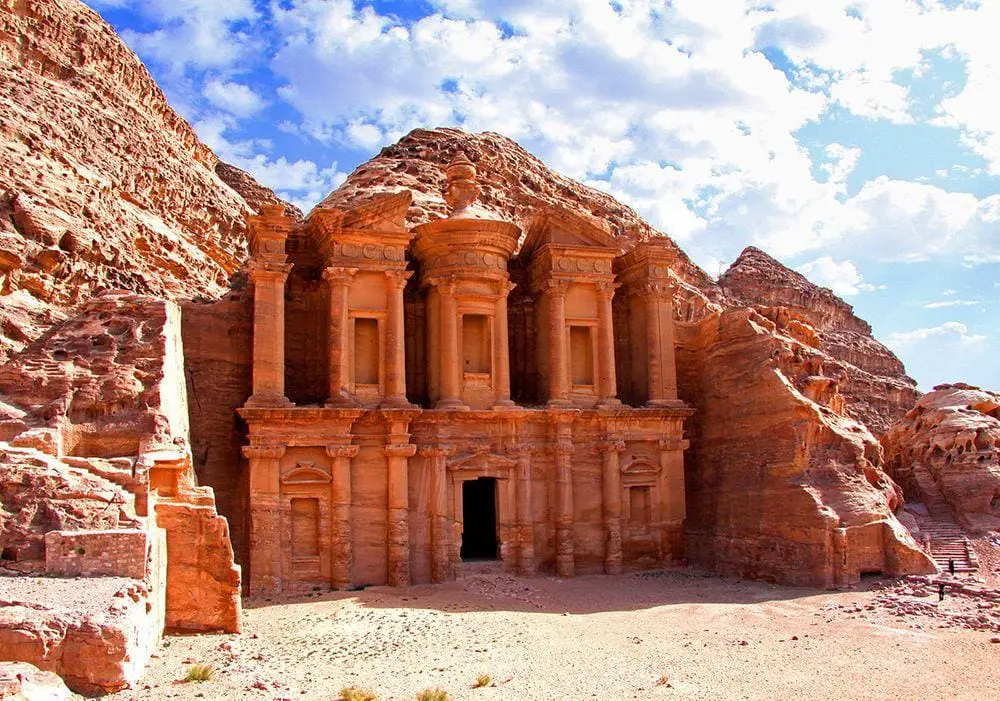Ancient cities and towns 🢔 Settlements 🢔 Archaeological wonders 🢔 Categories of wonders
Wonder
Petra
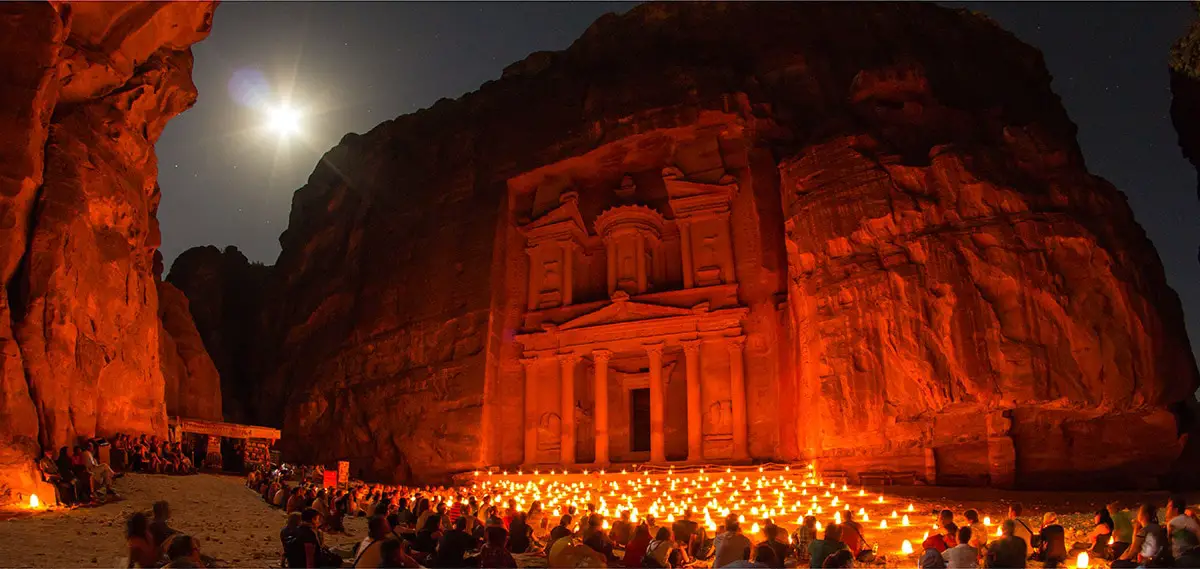
 In short
In short
There are hundreds of magnificent ancient cities around the world but none is similar to Petra. This amazing city was developed by Nabateans in the labyrinth of narrow cliff canyons and some of the most beautiful structures were directly cut in the sandstone cliff.
 85.1%
85.1%
GPS coordinates
Name in Arabic
Alternate names
Culture
Founded
Flourished
Abandoned
Area
UNESCO World Heritage status
Map of the site
If you see this after your page is loaded completely, leafletJS files are missing.
 In detail
In detail
Description
Petra is a wonderful and highly unusual ancient city which was built in narrow canyons of Jebel al-Madhbah some 800 – 1500 m above sea level.
Here over the area of some 20 km² have been discovered remnants of approximately 1000 structures. Only a fifth of these buildings has been explored thus far.
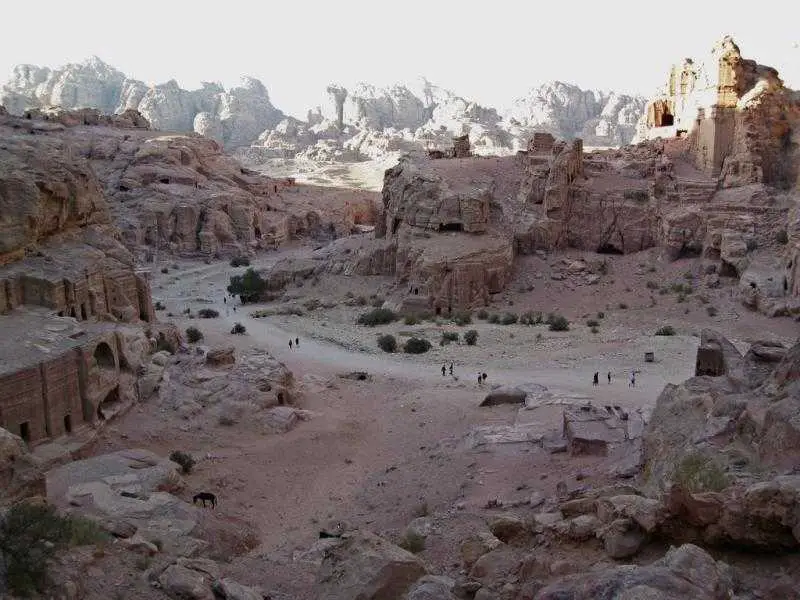
Trade city
City was located at the crossroads of important trade routes – caravan paths between Egypt and Syria as well as Arabia and Mediterranean (the legendary Incense Route). Thus Petra developed as a rich trade city.
In ancient times the city, most likely, was approached from the south. Nowadays tourists enter from the east, through impressive, narrow canyon – Siq. This canyon is approximately 1.5 km long, some 70 m deep and in the narrowest places just 2 m wide.
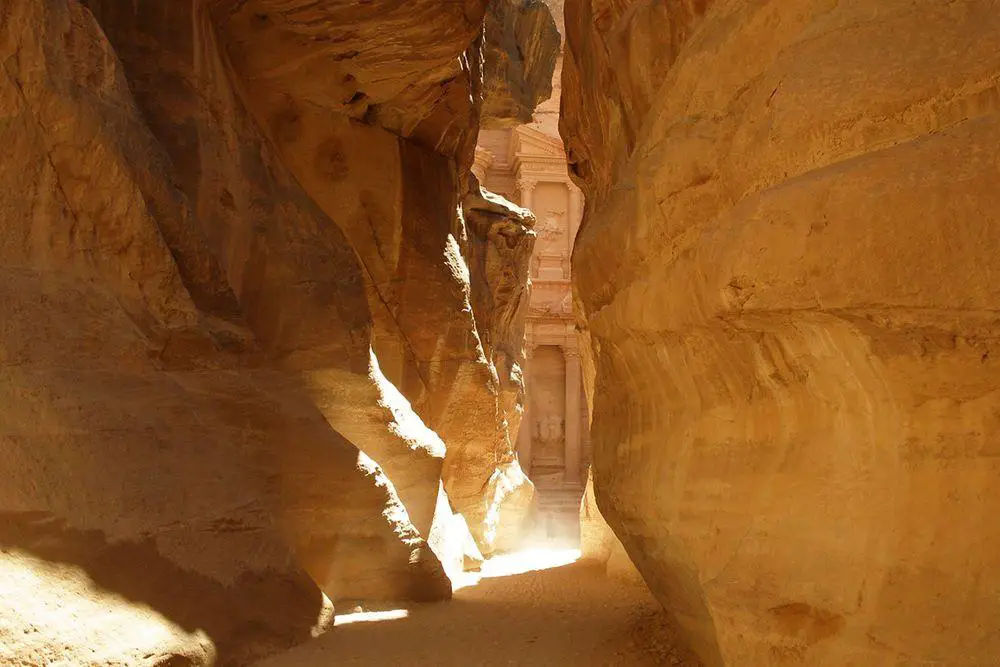
Water supply
Numerous inhabitants of Petra needed much water and in the desert-like climate this was a major challenge.
Nabateans created an ingenious irrigation system and as a result, the city had a perennial stream and a sufficient amount of water to create a desert oasis. This sophisticated system included water tunnels, pipes, and more than 200 cisterns. Nabateans managed to collect in the city water from all surroundings up to 25 km far.
Rather often these desert mountains received sudden gushes of rain and flash floods endangered the city in its narrow canyons. Also, this problem was solved – Nabateans built a series of dams and cisterns which stopped the excess water and provided water during the droughts.
Now, as many centuries without proper maintenance have passed, the water management system has gradually degraded and Petra again is endangered by floods.
History
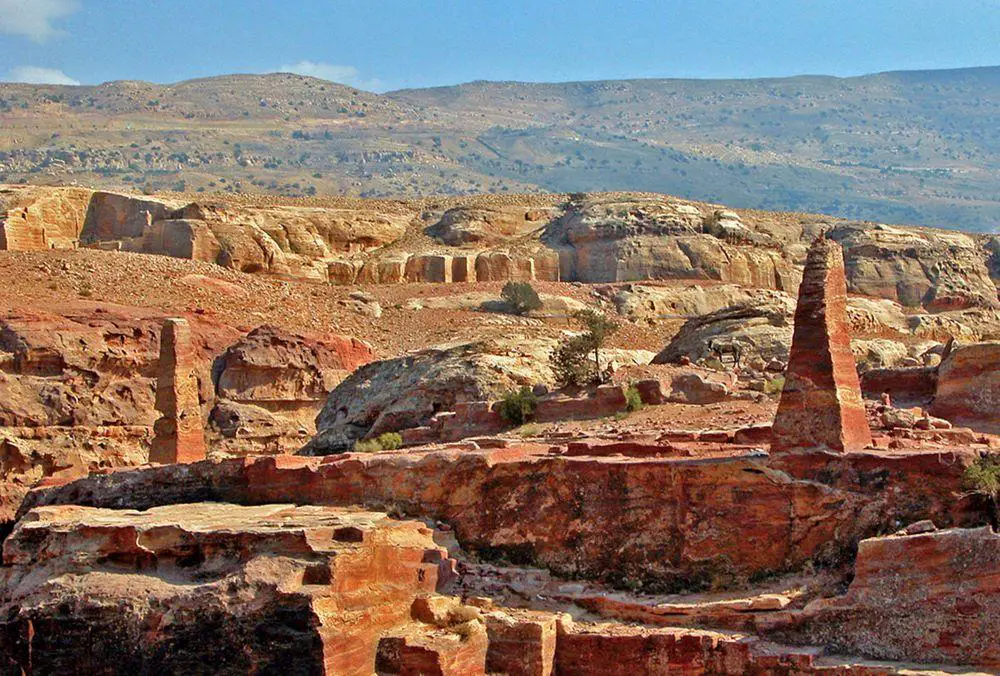
- Mountainous area around Petra has been inhabited for many millenia – already at 7000 BC nearby existed a settlement, now named Beidha. Petra though is much younger.
- Little is known about the beginnings of Petra, even its ancient name is not known.
- Current name – Petra – was given by Ancient Greeks. Greek historian Diodorus Siculus mentions some place named Petra – capital of Nabateans in 312 BC, although there are some doubts whether this is the current Petra.
- It is possible that Petra developed around an important shrine since the 6th or 5th century BC.
- Around this time or somewhat later Petra became the main centre of Nabateans (an ancient Aramaic culture).
- Site is linked to events mentioned in the Bible. Some specialists consider that Jebel al-Madhbah is the fabulous Mount Sinai and thus the valley with the ancient Petra is named also Wadi Musa – Valley of Moses.
- Fast development of Petra started in the 1st century BC. At this time here were built many structures in a distinct Hellenistic style.
- Petra and lands around it were included into the Roman Empire in 106 AD and Petra was capital of the Roman province Arabia Petraea.
- In Roman times Petra flourished and had some 30 – 40 thousand inhabitants.
- Approximately at 235 AD the construction activity in Petra came to a halt, most likely due to some catastrophe or conflicts. This contrasts with the comparatively near Palmyra which in this time continued to flourish and in a way attracted the lost importance of Petra.
- After the decline Petra continued to serve as comparatively important religious centre.
-
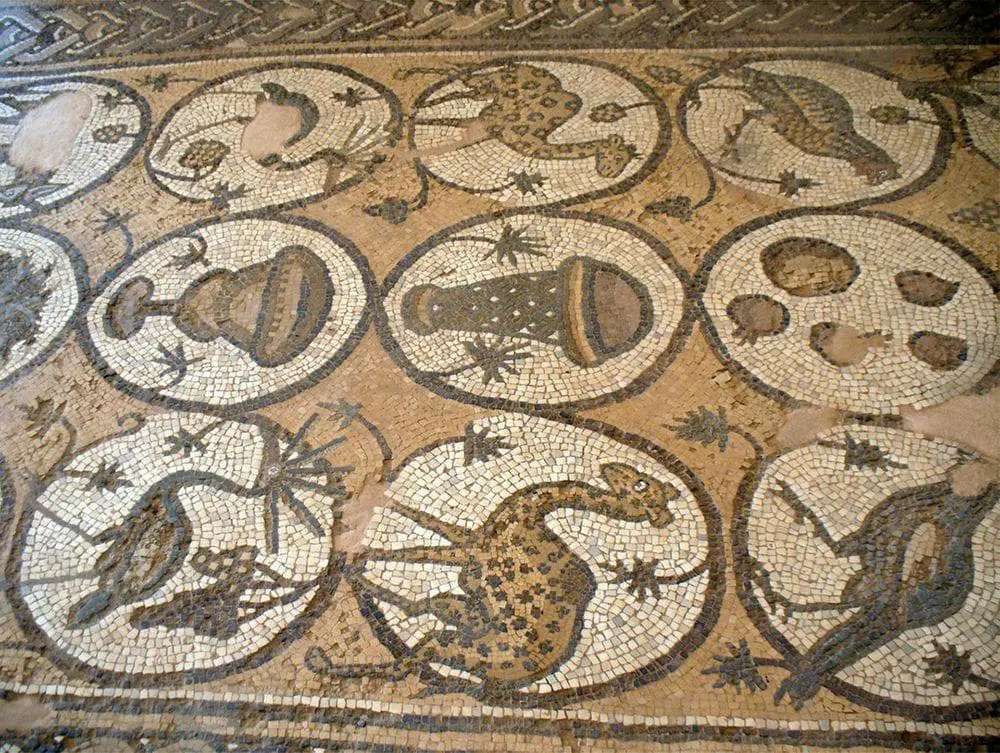
Byzantine mosaic on the floor of church / Institute for the Study of the Ancient World, Flickr / CC BY-SA 2.0 Christianity was introduced in the 4th century AD, several churches were built here.
- In 363 AD many buildings in the city were destroyed by an earthquake, there was damaged also the sophisticated water supply system.
- Another devastating earthquake took place in 551 AD.
- Islam was introduced here in 629 – 632 when the area was conquered by Arabs.
- Last inhabitants left Petra in 663.
- During the Crusades Petra for a while was under the control of Christians. Since these times in Petra are found also ruins of the castle of Crusaders.
- Ruins of Petra were well known to the people in the Near East and it was a tourist attraction.
- Europeans learned about this site only in 1812, when Johann Ludwig Burckhardt visited and described it.
- Today Petra has turned into a site of mass tourism, it is also a beloved place for the movie industry.
Outstanding buildings

Al Khazneh – the Treasury
When tourists enter Petra through the narrow canyon – Siq, they are greeted by one of the best structures in this ancient city – Al Khazneh. This is the most photographed landmark in Petra.
This giant structure has been cut in rock and is some 40 m tall and 25 m wide. This is an elaborate tomb which most likely was created in the 1st century BC.
Local Bedouins believed that bandits were storing treasure in an unaccessible stone urn of Al Khazneh (The Treasury in Arabic). They tried to get it – there are multiple bullet holes around this urn. In fact there can not be any treasure – urn is not hollowed out.
Roman theater

Further, behind Al Khazneh in the cliff is cut enormous theater. This impressive work was done in Roman times in the 1st century AD, destroying previous rock-cut tombs. Theater had some 5 – 10 thousand seats and was divided from the street with 25 m tall wall.
Earthquake destroyed the theater in 363 and it was rediscovered only in 1961.
Royal tombs
Rock-cut tombs belong to most ancient structures in Petra. There are distinguished several types of these structures – Nabatean and Greco-Roman and diverse interim stages. The oldest Nabatean rock-cut tombs here are from the 6th century BC. Many of these tombs have elaborate facades, especially the later ones which copy the Roman style in architecture.
Most impressive ones (besides Al Khazneh and Ad Deir) are 13 enormous rock-cut grave temples north from the theater. The largest among these tombs is the majestic Palace Tomb which has 49 m wide and 45 m tall facade. Another unusual grave temple is Urn Tomb with impressive arcades. It was turned into a church in 447 AD.
Ad Deir (The Monastery)
Ad Deir is a Nabatean temple devoted to Obodas I – deified Nabatean king who ruled in 96 – 85 BC.
It is another rock-cut structure with 39 m tall and 47 m wide facade. Ad Deir was built in the middle of the 1st century AD. In the 4th century it was used as a Christian monastery.
High Place of Sacrifice
On the summit of Jabal Attuf is located one of sacred Nabatean places – High Place of Sacrifice. It is artificially levelled summit of a mountain with a low sacrifice altar in the middle and two more than 6 m tall obelisks which are carved from solid rock. It is considered that obelisks represent Nabatean gods Dushara and Al Uzza. There are other similar shrines around the town.
 Linked articles
Linked articles
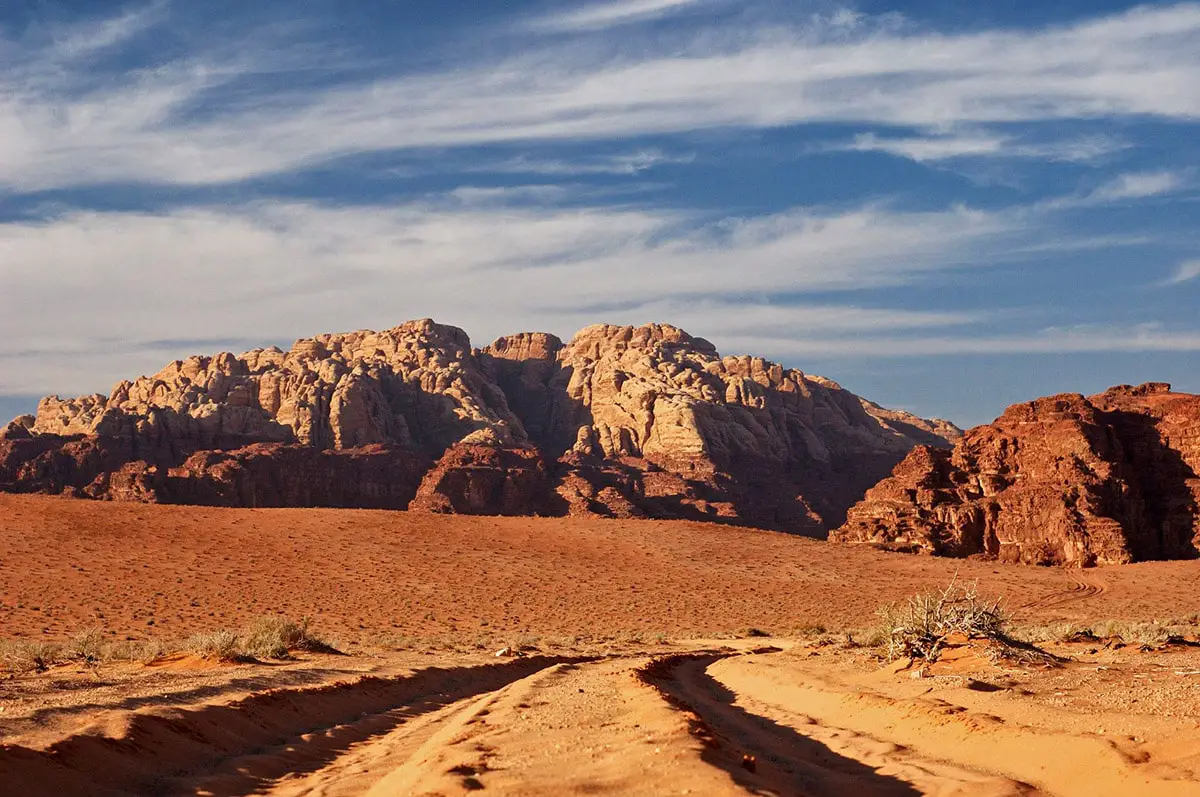
Wonders of Jordan
The history of civilization in Jordan goes further back in time than in most other places of the world. As a result, this country has a very rich archaeological heritage which puts in shadow the beautiful monuments of architecture and breathtaking natural scenery of this country.

Ancient cities and towns
It turns out that urban planning is a very old profession. The urban fabric of ancient settlements – their structure and evolution gives a lot of food for thoughts about the nature of humans and civilization.
Wondermondo includes in the category of ancient cities and towns those settlements which have developed as urban areas at least 1500 years ago: around 500 AD.

Abandoned cities and towns
The main impression created by abandoned cities is intimate. This is a mixed feeling of sadness, unclear anxiety (“my city will not be eternal either”), and at the same time – inspiration from the abilities of our ancestors. Long ago, without electricity, paper, or different mechanisms, they managed to create magnificent structures, that covered many square kilometers.
 Recommended books
Recommended books
Petra: The History of the Rose City, One of the New Seven Wonders of the World
Petra: The History of the Rose City, One of the New Seven Wonders of the World looks at the history of Petra from prehistoric times to the end of the Crusades, as well as the city’s “rediscovery” in the 19th century and how it has entered the world’s imagination since then. Along with pictures depicting important people, places, and events, you will learn about Petra like never before.
Petra: The True And Surprising History Of The Lost City Of Stone
Just a few hours south of the country’s capital, Amman, the area was officially founded by the Arab tribe of nomads. This occurred centuries before Christ was born. This tribe was well known for their impeccable engineering, agriculture, trading, and of course, stone-carving skills. Much is still unknown about this ancient culture, but we know for sure that they were incredibly talented artists and engineers.

